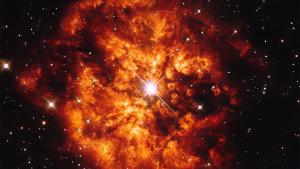Blog
Children of the Wolf
2 January 2018
 ESA/Hubble & NASA, Judy Schmidt
ESA/Hubble & NASA, Judy SchmidtThere is much we still don’t know about the origin of our Sun. We know that stars form within large clouds of gas and dust known as stellar nurseries. These clouds collapse under their own weight to form hundreds of stars at once. But something has to trigger that collapse. The most popular view is that it is triggered by supernovae, which sends shock waves through the cloud. But a new model argues that the birth of our Sun might have been triggered by the more subtle process of a Wolf-Rayet star.
A Wolf-Rayet star is an old massive star on its way to becoming a supernova. They are distinguished by extremely strong stellar winds and their spectral lines tend to show they are rich in helium, but don’t contain much hydrogen. They are often observed within a nebula produced when the outer layers of the star are pushed outward.
Wolf-Rayet stars cast off outer layers gradually, rather than through a single explosion like supernovae, so it was thought that they couldn’t trigger star formation within a stellar nursery. But new computer simulations show that they might encourage stars to form within the layers of the surrounding nebula. The strong stellar winds of a Wolf-Rayet star can cause the surrounding nebula to compress into a more dense layer surrounding the star. Known as a Wolf-Rayet bubble, simulations show that it could be dense enough to trigger star formation.1
This idea would seem to be supported by the composition of the early solar system. Meteorites from the early solar system have higher levels of aluminum-26 and lower levels of iron-60 than the surrounding interstellar medium. Wolf-Rayet stars produce lots of aluminum-26, which would tend to get caught within the bubble.
There are other possible explanations for these elemental abundances, so the Wolf-Rayet model isn’t conclusive. It does show, however, that there is more than one way to trigger star formation, and the origin of our Sun may have a richer history than we once thought.
Dwarkadas, Vikram V., et al. “Triggered star formation inside the shell of a Wolf–Rayet bubble as the origin of the Solar System.” The Astrophysical Journal 851.2 (2017): 147. ↩︎